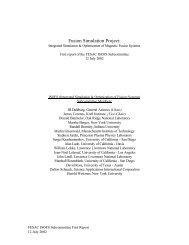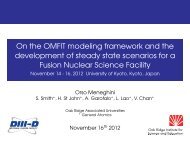introduction to gyrokinetic and fluid simulations of ... - Our Home Page
introduction to gyrokinetic and fluid simulations of ... - Our Home Page
introduction to gyrokinetic and fluid simulations of ... - Our Home Page
Create successful ePaper yourself
Turn your PDF publications into a flip-book with our unique Google optimized e-Paper software.
A complete description <strong>of</strong> a plasma<br />
is given by the particle distribution function Fs(x, v, t), the density <strong>of</strong> particles<br />
at (near) position x with velocity v <strong>and</strong> time t, for species s (with charge q s <strong>and</strong><br />
mass ms).<br />
The charge density <strong>and</strong> current needed for Maxwell’s equations <strong>to</strong> determine<br />
the electric <strong>and</strong> magnetic fields is then:<br />
σ(x, t) = <br />
s qs<br />
<br />
d 3 vFs(x, v, t)<br />
Fs is determined by the Vlasov-Boltzmann equation<br />
∂F<br />
∂t<br />
+ v · ∂F<br />
∂x<br />
+ qs<br />
ms<br />
⎛<br />
⎞<br />
⎜<br />
⎝ E + v × B ⎟<br />
⎠ ·<br />
c<br />
∂F<br />
∂v<br />
j(x, t) = <br />
s qs<br />
<br />
d 3 vvFs(x, v, t)<br />
= Collisions + sources + sinks ≈ 0<br />
where sources + sinks includes radiation cooling <strong>of</strong> electrons, ionization <strong>and</strong><br />
recombination changes <strong>of</strong> ion charge state, etc.





